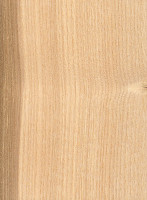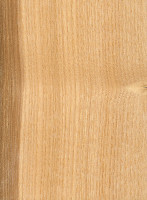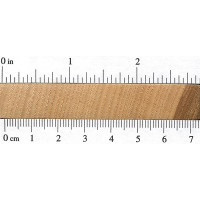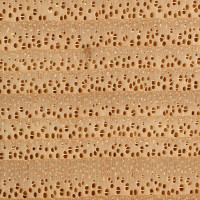 |
Common Name(s): Green Ash Scientific Name: Fraxinus pennsylvanica Distribution: Eastern and Central North America Tree Size: 50-65 ft (15-20 m) tall, 1-2 ft (.3-.6 m) trunk diameter Average Dried Weight: 40 lbs/ft3 (640 kg/m3) Specific Gravity (Basic, 12% MC): .53, .64 Janka Hardness: 1,200 lbf (5,340 N) Modulus of Rupture: 14,100 lbf/in2 (97.2 MPa) Elastic Modulus: 1,660,000 lbf/in2 (11.40 GPa) Crushing Strength: 7,080 lbf/in2 (48.8 MPa) Shrinkage: Radial: 4.6%, Tangential: 7.1%, Volumetric: 12.5%, T/R Ratio: 1.5 |
Color/Appearance: The heartwood is a light to medium brown color. Sapwood can be very wide, and tends to be a beige or light brown; not always clearly or sharply demarcated from heartwood.
Grain/Texture: Has a medium to coarse texture similar to oak. The grain is almost always straight and regular, though sometimes curly or figured boards can be found.
Rot Resistance: Heartwood is rated as perishable, or only slightly durable in regard to decay. Ash is also not resistant to insect attack.
Workability: Produces good results with hand or machine tools. Responds well to steam bending. Glues, stains, and finishes well.
Odor: Gives off a distinct, moderately unpleasant smell when being worked.
Allergies/Toxicity: Ash in the Fraxinus genus has been reported to cause skin irritation, and a decrease in lung function. See the articles Wood Allergies and Toxicity and Wood Dust Safety for more information.
Pricing/Availability: Ash is among the least expensive utility hardwoods available domestically; it should compare similarly to oak in terms of price.
Sustainability: This wood species is not listed in the CITES Appendices, but is on the IUCN Red List. It is listed as critically endangered due to a projected population reduction of over 80% in the next three generations, caused by effects of introduced taxa. (See notes on the emerald ash borer in the comments section below.)
Common Uses: Flooring, millwork, boxes/crates, baseball bats, and other turned objects such as tool handles.
Comments: The emerald ash borer (Agrilus planipennis), believed to have been inadvertently introduced from Asia sometime in the 1990s, was first detected in Michigan in 2002. Lacking natural predators, uncontrolled populations of this invasive species spread very rapidly throughout North America, devastating local populations of ash trees. The beetles’ larvae bore into a tree and feed on the inner bark, eventually killing the entire tree. The insects are responsible for the deaths of hundreds of millions of ash trees across the United States and Canada. Green Ash and Black Ash trees are preferentially attacked by the insects, followed by White Ash and Blue Ash.
Green Ash is one of a handful of species in the Fraxinus genus that are used as commercial lumber. It has strength/mechanical properties that are very close to the related White Ash (Fraxinus americana) and is frequently mixed and sold as “White Ash.”
Green Ash has excellent shock resistance, and along with hickory (Carya spp.), it is one of the most commonly used hardwoods for tool handles in North America—particularly in shovels and hammers where toughness and impact resistance is important.
When stained, ash can look very similar to oak (Quercus spp.), although oaks have much wider rays, which are visible on all wood surfaces—even on flatsawn surfaces, where they appear as short, thin brown lines between the growth rings. Ashes lack these conspicuous rays.








Jason,
Generally speaking, the drier a wood becomes, the stronger and stiffer it will be. What you describe would not be typical for Ash. Do you think that it’s possible that the wood has been exposed to prolonged periods of high relative humidity (over 70%)? Unless there was some sort of pre-existing weakness in the wood, such as a knot, the failure may be due to some sort of fungal decay.
Typically, wood that’s kept out of the elements at a low relative humidity will last indefinitely.
Hi, my house is 96 years old and I live in Kitchener Ontario, Canada. From what I can tell most of the trim( windows, doors and baseboards) and doors are made of Ash. My main staircase has the same grain, also original to the house. Recently I was having work done on the house and a worrker went through a stair. The wood felt extremely light and dry. Is it possible that my stairs have dried out to the point that they are no longer strong? is this typical of ash wood? I am looking for advice to help me… Read more »